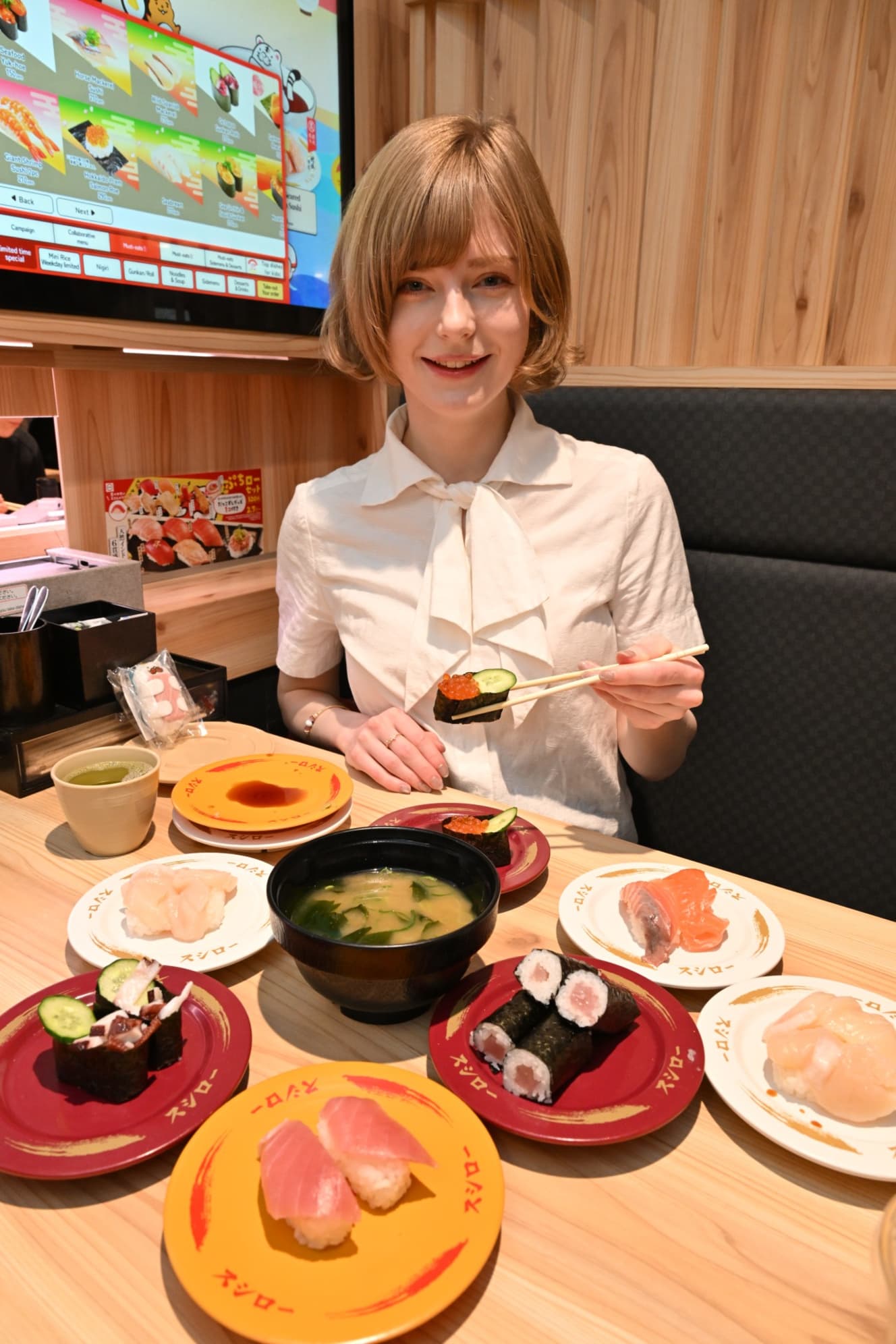Dutch Model Ella Freya’s Revelations on the Differences Between Japanese Sushi and Sushi Abroad Shock Many

“I wonder which one to start with~”
Arranging favorite sushi toppings such as ikura, salmon, crab, and natto rolls on the table, and contemplating with a smile, is Ella Freya (26), who hails from the Netherlands and showcases her multifaceted abilities as a fashion model, YouTuber, and more. She’s also an influencer with over 2.9 million followers on social media. This time, we closely followed Ella’s off-duty appearance in Japan, revealing a surprising side of her.
“I love sushi, so whenever I come to Japan, I make sure to go eat some. I’ve also tried Genki Sushi in Singapore and Sushiro in Thailand. Overseas sushi, like Genki Sushi, has an ethnic flavor profile, and they have a wide variety of seared sushi. The taste of sushi varies a bit depending on the country.”
At the Sushiro Shinjuku Nishiguchi branch she visited this time, there are giant monitors measuring about 50 cm vertically and 1.5 meters horizontally installed at each table, with sushi plates flowing on a “virtual lane.” This new store, called “Digital Sushiro Vision” (nicknamed “Digi-Sushi”), serves as an experimental store introduced to explore the possibilities of digital technology.
“The touchscreen menu can be set to English, so combined with the pictures, it’s pretty easy to understand. It’s hygienic and convenient that they prepare the sushi after you order and deliver it to your lane. Although there are conveyor belt sushi places in the Netherlands too, some of the items rotating on the belt for many rounds made me a little hesitant.”
Ella always makes sure to eat sushi when she visits Japan, but she recalls feeling bewildered when she visited a sushi restaurant in Tokyo four years ago and drew attention from the entire establishment.
“The regulars at the restaurant were checking my every move, commenting on how well I used chopsticks and that I could eat raw fish. It was embarrassing. I wanted to leisurely enjoy my meal with some sake, but I found the sushi chef intimidating, so I felt more comfortable at the casual conveyor belt sushi places.”
The Netherlands, being a coastal country, also has plenty of seafood available. Ella often sees salmon, sea bream, tuna, squid, flounder, halibut, and mussels at local fish markets. However, unlike in Japan, where fish is often presented alive to showcase its freshness, this isn’t common in Dutch eateries.
“In Japan, they would show you the fish alive before preparing it, but I don’t think that would be well-received by the Dutch. I was a bit surprised the first time I was shown that.”
She’s a big fan of Japan and her opportunities are expanding. She was appointed as the first foreign model for “Shimamura,” the second-largest clothing chain store in Japan after Uniqlo. She trains at the gym and practices yoga to maintain posture and body balance. However, standing at 167cm tall and not having a typical model physique, she worries.
“So, as the shooting day approaches, I save on staple foods. Consuming salt causes my face to swell, so I also cut back on soy sauce and miso soup. It was tough shooting for hours in a day, but it was fun to wear lots of cute clothes. I’d like to try fashion modeling again.
I’d like to appear more on variety shows, but sometimes I struggle because I can’t understand Japanese well. Even though I might not seem like it, I enjoy making people laugh by telling jokes.”
The hot and humid Japanese summer doesn’t agree with her body, so she plans to return to the Netherlands for a while. Without time to admire the cherry blossoms, she’ll spend her days buying souvenirs for her family and friends.
“They request mentaiko and tarako pasta sauce. Kit Kats are also appreciated. There are so many delicious things in Japan, so there are many requests. We need to be careful not to overeat.”
After recharging in the Netherlands, she plans to return to Japan when summer is over.
“I need to edit a lot of YouTube videos in the Netherlands. Please check them out as I share them on social media.”
When the summer heat subsides, we may see this smile again. During her next visit to Japan, we might even see Ella telling jokes with her characteristic humor.
Here is Ella’s latest photo book, “6th Digital Photo Book: Moe Moe Moe”!





Interview and text by: Daisuke Iwasaki PHOTO: Takero Yui PHOTO: Mitsutoshi Watanabe